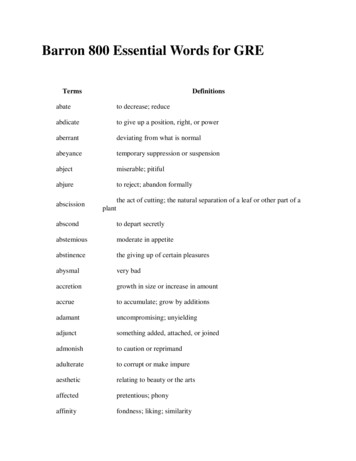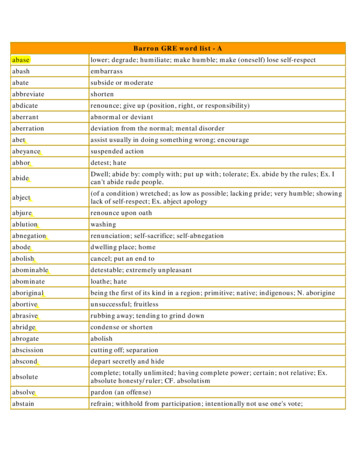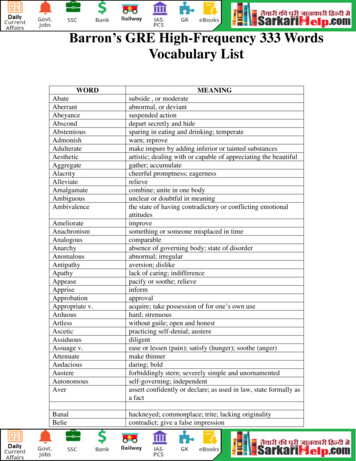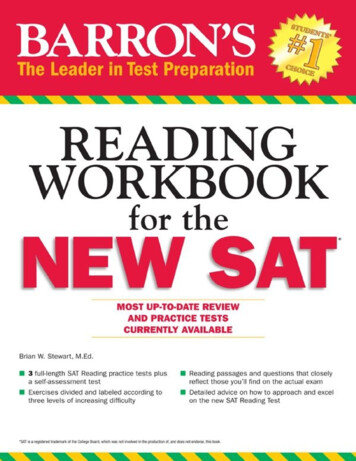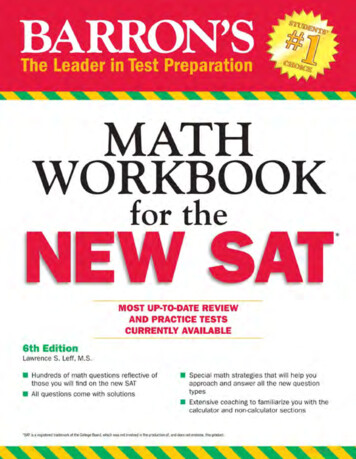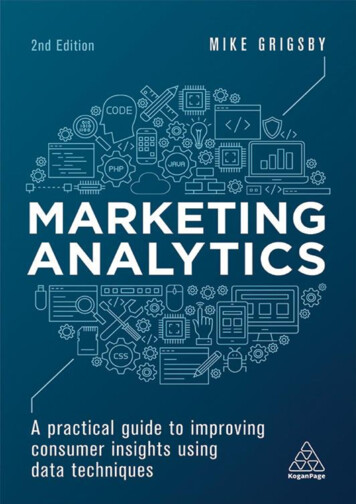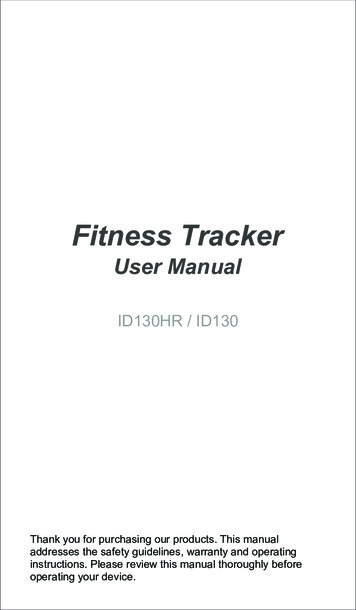
Transcription
Copyright 2013, 2011, 2009, 2007, 2005, 2003, 2000, 1999, 1997,1994, 1992, 1990, 1988, 1985, 1982, 1981, 1979, 1977, 1973by Barron’s Educational Series, Inc.All rights reserved.No part of this publication may be reproduced or distributed inany form or by any means without the written permissionof the copyright owner.All inquiries should be addressed to:Barron’s Educational Series, Inc.250 Wireless BoulevardHauppauge, New York 11788www.barronseduc.comeISBN: 978-1-4380-9210-2Revised eBook publication: June, 2013.
ContentsAcknowledgmentsPrefaceTimetable for a Typical Computer-Based Graduate Record ExaminationPART 1: Introduction/Diagnostic Test1What You Need to Know About the GREAn Overview of the Computer-Based GRE General TestCommonly Asked Questions About the Computer-Based GREGRE Test FormatVerbal ReasoningQuantitative AbilityAnalytical Writing2Test-Taking Tactics for the Computer-Based GREHelpful HintsA Guided Tour of the Computer-Based GRE3A Diagnostic TestSimulate Test ConditionsTestSelf-AppraisalAnswer KeyAnswer ExplanationsPART 2: Verbal Ability: Tactics, Review, and Practice4Sentence Equivalence and Text Completion QuestionsTesting TacticsPractice ExercisesAnswer Key5Reading Comprehension QuestionsTesting TacticsPractice Exercises
Answer Key6Reviewing VocabularyThe GRE High-Frequency Word ListThe GRE Master Word ListPART 3: Analytical Writing: Tactics, Strategies, and PracticeIntroduction to Part 37Analytical WritingScoring GuidelinesEssay Writing: The 5-Step ApproachHow to Handle the Argument-Analysis TaskTesting TacticsPractice ExercisesPART 4: Quantitative Ability: Tactics, Strategies, Practice, and ReviewIntroduction to Part 48General Math StrategiesTesting TacticsPractice ExercisesAnswer KeyAnswer Explanations9Discrete Quantitative QuestionsTesting TacticsPractice ExercisesAnswer KeyAnswer Explanations10Quantitative Comparison QuestionsTesting TacticsPractice ExercisesAnswer KeyAnswer Explanations11Data Interpretation QuestionsTesting TacticsPractice ExercisesAnswer Key
Answer Explanations12Mathematics ReviewArithmeticAlgebraGeometryPART 5: Model Tests13Model TestsModel Test 1Answer KeyAnswer ExplanationsModel Test 2Answer KeyAnswer ExplanationsSome of the text, illustrations, mathematical equations, etc., will appear differently depending onwhat device you are using. Please adjust accordingly.This eBook contains hyperlinks that will help you navigate through content, bring you to helpfulresources, and allow you to click between questions and answers.For the best optimization of reading passages, math figures, and equations, please turn your devicehorizontally.
Acknowledgmentshe authors gratefully acknowledge the following for permission to reprint reading passages inthe book.TBook PassagesPage 34: From Classic Authors of the Gilded Age by Darrel Abel. Copyright 1963 by Barron’sEducational Series.Page 38: From the National Biological Information Infrastructure.Page 107: From “So Many Female Rivals” by Christine Froula, The New York Times Book Review,February 7, 1988.Page 108: Ladislas Segy, “African Sculpture Speaks,” Dover Publications, New York, 1958. Bypermission of Helena Segy.Page 536: From Black Leaders of the Twentieth Century. Copyright 1982 by the Board of Trustees ofthe University of Illinois. Used with permission of the University of Illinois Press.Page 569: From Vol. 15 of Americas, Copyright 1963 by the Organization of American States.Page 579: From Eyes on the Prize: Civil Rights Years, edited by Clayborne Carson et al. Copyright 1987 by Penguin Books. Blackside, Inc. 1991, with permission.
Prefaces a prospective graduate student concerned with professional advancement, you know theimportance of using good tools and drawing on solid research. In this Twentieth Edition ofBarron’s GRE we offer you both.This revision contains the fruits of our close study of the 2011 changes to the GRE General Test.We have scrutinized hundreds of actual GRE questions, traced dozens of GRE reading passages totheir sources, analyzed subsets of questions by order of difficulty and question type. We have gonethrough all the topics in the analytical writing section, categorizing the actual issues you willencounter on your test and analyzing the argument passages, pinpointing their logical flaws. In theprocess, we have come up with the following features, which should make this Twentieth Editionparticularly helpful to you:ATypical GRE Questions AnalyzedWe will take you step by step through more than 1,000 practice verbal and mathematical questionsthat simulate actual GRE questions, showing you how to solve them and how to avoid going wrong.Testing TacticsWe provide you with dozens of proven testing tactics that will help you attack the different types ofquestions on the GRE.High-Frequency Word ListThis edition contains a newly revised 320-word High-Frequency Word List—320 critical wordsfrom abate to zealot that have occurred and recurred on actual published GREs—plus Barron’s GREMaster Word List, your guide to the level of vocabulary expected of graduate school students.Comprehensive Mathematics ReviewWe present you with extensive mathematical review of all the topics that you need to know. This isespecially valuable for college students and adults who haven’t taken math since high school.GRE-Modeled TestsWe have created for you a Diagnostic Test that will enable you to pinpoint your areas of weaknessright away and concentrate your review on subjects in which you need the most work, plus two
Model Tests, all with answers completely explained, that in format, difficulty, and content echotoday’s GRE.Computer GRE UpdateIn this edition we will introduce you to the latest version of the computer-based GRE—and, explaineverything you need to know about how to take the computerized GRE.Analytical Writing UpdateWe provide you with an introduction to the GRE analytical writing section, familiarizing you with therange of topics covered and giving you helpful hints on how to write clear, cogent essays in no time atall.This Twentieth Edition once more upgrades what has long been a standard text. It reflects thecontributions of numerous teachers, editors, and coaches, and the dedication of the staff at Barron’s. Italso reflects the forensic and rhetorical skills of Lexy Green, Director of Debate at the CollegePreparatory School, to whom we owe special thanks. We, the authors, are indebted to all theseindividuals for their ongoing efforts to make this book America’s outstanding GRE study guide.
Timetable for a Typical Computer-BasedGraduate Record ExaminationTotal Time: 4 hoursNOTE: Sections 2 through 6 can come in any order—for example, Section 2 could be a Quantitative Ability sectionand the Experimental Section could be any section except Section 1. Although the Experimental Section will notcount in your score, it will look identical to one of the other sections—you won’t know which section it is, so youmust do your best on every section of the test.
PART 1INTRODUCTION/DIAGNOSTIC TEST
CHAPTER1What You Need to Know About the GREAN OVERVIEW OF THE COMPUTER-BASED GRE GENERALTESThe GRE General Test is an examination designed by the Educational Testing Service (ETS) tomeasure the verbal, quantitative, and analytical writing skills you have developed in the courseof your academic career. High GRE scores strongly correlate with the probability of success ingraduate school: the higher you score, the more likely you are to complete your graduate degree. Forthis reason, many graduate and professional schools require applicants to take the GRE General Test,a test now given only on computer. (They may also require you to take a GRE Subject Test in yourparticular field. Subject Tests currently are available in 14 fields.)The computer-based GRE General Test you take will have five or six sections. There will alwaysbeT one Analytical Writing section composed of two 30-minute tasks (60 minutes) two 20-question Verbal Ability sections (30 minutes each) two 20-question Quantitative Ability sections (35 minutes each)In addition, there may be an unidentified Experimental Section, which would be a third verbal or quantitative sectionOccasionally, there may be an identified optional research section (but not if there is an Experimental Section)The verbal section measures your ability to use words as tools in reasoning; you are tested notonly on the extent of your vocabulary but on your ability to discern the relationships that exist bothwithin written passages and among individual groups of words. The quantitative section measuresyour ability to use and reason with numbers and mathematical concepts; you are tested not onadvanced mathematical theory but on general concepts expected to be part of everyone’s academicbackground. The mathematics covered should be familiar to most students who took at least two yearsof math in a high school in the United States. The writing seaion measures your ability to makerational assessments about unfamiliar, fictitious relationships and to logically present yourperspective on an issue.COMMONLY ASKED QUESTIONS ABOUT THE COMPUTER-
BASED GREHow Does the GRE Differ from Other Tests?Most tests college students take are straightforward achievement tests. They attempt to find out howmuch you have learned, usually in a specific subject, and how well you can apply that information.Without emphasizing memorized data, the GRE General Test attempts to measure verbal, quantitative,and analytical writing skills that you have acquired over the years both in and out of school.Although the ETS claims that the GRE General Test measures skills that you have developed overa long period, even a brief period of intensive study can make a great difference in your eventualGRE scores. By thoroughly familiarizing yourself with the process of computer-based testing, theGRE test format, and the various question types, you can enhance your chances of doing well on thetest and of being accepted by the graduate school of your choice.What Is It Like to Take a Computer-Based GRE?You can go to the ETS’s official GRE website—www.ets.org/GRE/—and download their freePOWERPREP II software, which includes a test preview tool and a practice test.When you actually take the GRE, you sit in a carrel in a computer lab or testing center, facing acomputer screen. You may be alone in the room, or other test-takers may be taking tests in nearbycarrels. With your mouse, you click on an icon to start your test. The first section of the test is theAnalytical Writing section, and you will have 60 minutes in which to complete the two writing tasks.When you have finished the writing section, you will have a one-minute break to take a few deepbreaths and get ready for the next four or five sections, each of which will consist of 20 multiplechoice verbal or quantitative questions. When the break is over, the first question in Section 2appears on the screen. You answer it, clicking on the oval next to your answer choice, and then, readyto move on, you click on the box marked Next. A new question appears on screen, and you go throughthe process again. Be sure to answer every question. Because there is no penalty for an incorrectanswer on the GRE General Test, when you don’t know an answer, try to make an educated guess byeliminating clearly incorrect choices; if you can’t eliminate any choices, make a wild guess, andmove on.At the end of the second section, you are given another one-minute break. After finishing the thirdsection, you have a ten-minute break. There will be two more one-minute breaks—after the fourth andfifth sections.Why Do Some People Call the Computer-Based General Test a CAT?CAT stands for Computer-Adaptive Test. What does this mean? It means that the test adapts to yourskill level: it is customized.TIP
Be Prepared1. Make sure to bring your photo ID to the test center.2. Do not bring food, drinks, or tobacco products to the testcenter.3. No cell phones, smartphones, PDA’s, or other electronicdevices are allowed in the testing center.4. All personnel items brought with you to the test center aresubject to inspection.What happens is that after you complete the first quantitative or verbal section, the computerprogram assesses your performance and adjusts the difficulty level of the questions you will have toanswer in the second quantitative or verbal section. The more questions you answer correctly in thefirst section, the harder will be the questions that you will be given in the second section. However,the harder the questions are, the more they are worth. So your raw score depends on both the numberof questions you answer correctly and the difficulty level of those questions.Actually, the GRE is much less computer-adaptive than it used to be. It used to adapt the level ofquestions you received continuously; after every question the program would assess yourperformance and determine the level of difficulty of the next question. Now, it doesn’t make thatdetermination until you have completed an entire section.Can I Tell How Well I’m Doing on the Test from the Questions theComputer Assigns Me?Don’t even try; it never pays to try to second-guess the computer. There’s no point in wasting time andenergy wondering whether it’s feeding you harder questions or easier ones. Let the computer keeptrack of how well you’re doing — you concentrate on answering correctly as many questions as youcan and on pacing yourself.Should I Guess?Yes, you must! You are not going to know the correct answer to every question on the GRE. That’s agiven. But you should never skip a question. Remember, there is no penalty for an incorrect answer.So if a question has you stumped, eliminate any obviously incorrect answer choices, and then guessand don’t worry whether you’ve guessed right or wrong. Your job is to get to the next question youcan answer. Just remember to use the process of elimination to improve your guessing odds.H
Barron’s GRE we offer you both. This revision contains the fruits of our close study of the 2011 changes to the GRE General Test. We have scrutinized hundreds of actual GRE questions, traced dozens of GRE reading passages to their sources, analyzed subsets of questions by order of difficulty and question type. We have gone through all the topics in the analytical writing section .
